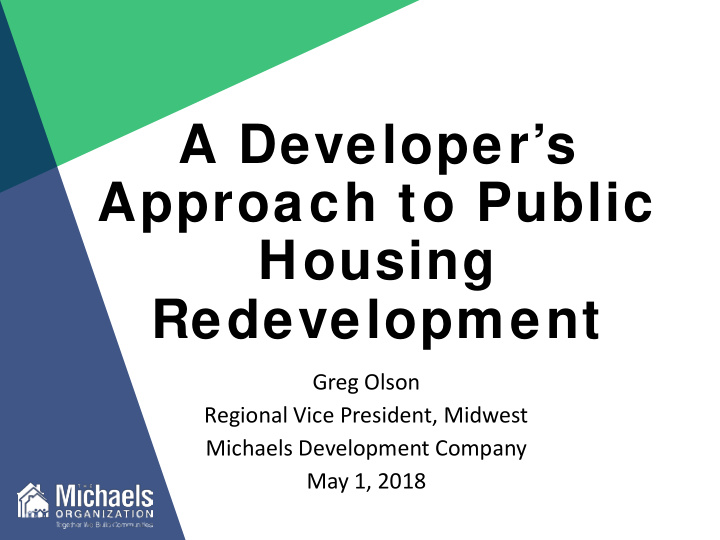



A Developer’s Approach to Public Housing Redevelopment Greg Olson Regional Vice President, Midwest Michaels Development Company May 1, 2018
Request for Proposal or Request for Qualifications There are Housing Authorities with wide ranges of experience • and capacity Development projects can take years of planning on the PHA • side and can include consultant and legal input It is important how RFPs and RFQs are written • What are the Housing Authority’s goals? • I How to get the word out? • Developers will evaluate an RFP/RFQ to determine how much • time it will take to complete and what resources it has available Developers will also evaluate whether the RFP/RFQ is • winnable and can generate a reasonable fee A detailed RFP for a specific site can take multiple weeks to • complete Team: Architect, General Contractor, Property Manager, • Consultant(s), Environmental Engineer, Attorney
Interview Following a well-presented submittal, a developer hopes to be called in • for an in-person interview Housing Authorities should include multiple people in decision-making • roles in the interview process Developers will often bring key team members (architect, property • manager, general contractor) to the interview An interview allows a developer to better explain its proposal • A face to face meeting allows a developer the ability to go into detail on • specific development projects, including challenges and successful outcomes.
Selection Process Housing Authorities may ask for additional information before selecting • a developer Housing Authorities should consider many factors before selecting a • developer Experience with similar projects • Diversity of team • Regional/local knowledge • Fee sharing/ownership structure • Specific personnel assigned to project • Aligned development goals • Financial capacity • Staff and Board roles • Points and scoring are often used, but may not identify a clear winner •
The Development Agreement This is an important document as it outlines the relationship • between the developer and the housing authority Should address important issues (among other things): • Timeline • Predevelopment Loan (if any) • Environmental responsibilities • Roles and responsibilities of each party • Community engagement • Legal and HUD requirements • Fee sharing/ownership structure (dev fee, sale, seller’s • note, ground lease, etc.) Right of first refusal/year 15 • Waterfall cash flow for asset management • Social service funding • Tenant rights/responsibilities • Housing Authority should consider outside counsel if • internal counsel hasn’t negotiated a similar document.
Project(s) RAD Conversion High rise elderly from PH to RAD • Multi-family redevelopment using RAD • Conversion of ACC units in mixed-income • developments to RAD Developer can leverage debt (HUD, Fannie, • Freddie, Conventional) based on RAD rents Courtyard Apartments 4% tax credits and soft debt • Philadelphia, PA Scope of work is important because of limited funding • Relocation of residents is a primary issue in RAD conversion • projects (compare to highway construction) Relocation Strategy/Plan • Relocation coordinator • Hoteling on site • Regular communication with contractor and tenants •
Public Housing Redevelopment HOPE VI or Capital projects • Demolish and replace • Substantial rehab or new construction • Typically used on dated, barracks-style apartments • Can be paired with 4% or 9% tax credits • Infrastructure development for new communities can be very • expensive Reddick Family Franklin, TN
Choice Neighborhoods Initiative (CNI) Planning Grant • Implementation Grant • Long lead time for planning • Partner Agencies/Firms • School(s) • Employer(s) • Local government • Social Service agencies • Developer • Wholesale redevelopment of community • Developer’s role can be primary or secondary • Camden CNI Camden, NJ Very competitive process •
For Sale Many Housing Authorities are looking to develop • single-family for sale as part of a redevelopment strategy Plans must be grounded in reality • Cost of construction versus sales price (GAP) • Davis-Bacon issues • Many multi-family developers do not specialize in an • affordable single-family product. Lease to purchase option • Might make sense to separate for-sale project • and procurement from rental project. Westhaven Park City Flats Chicago, IL
Team Members Architect: Multi-family knowledge, QAP knowledge, PHA knowledge General Contractor: MBE/WBE/Section 3 experience, Multi-family construction experience, rehab versus new construction, team player Legal: Programmatic knowledge, HUD experience Consultants: Environmental, RAD/Finance, Marketing/Branding, Relocation Property Manager: Software compatibility, experience with tenant population, social services
Financial Parameters General project thresholds • 9% tax credit project: 45 – 75 units • 4% tax credit project/RAD: Can be larger • Smaller developer or not-for-profit may be a good fit • for smaller projects A developer is able to make financial guarantees to • lenders and investors A developer often has greater access to debt and equity • based on relationships Soft sources are often required on projects – PHA • sources, grants, local funds (CDBG, HOME, local affordable housing funds) Project based vouchers can be used to leverage • significant debt on projects Fee sharing with PHAs: development fee, cash flow • Management role for PHAs: Asset management fee, • management after guarantees
Community Engagement Role of PHA • Often ground work is laid by PHA early (pre-developer) • Community meetings • Relationship with municipality • Resident meetings • PHA staffing may be limited for extensive community • engagement PHA has existing relationships that can be leveraged • Tenant leadership can play a role • Developer can design and implement a community • engagement plan, from conceptual design input through construction (MBE/WBE/Section 3)
Thank You! Questions?
Recommend
More recommend